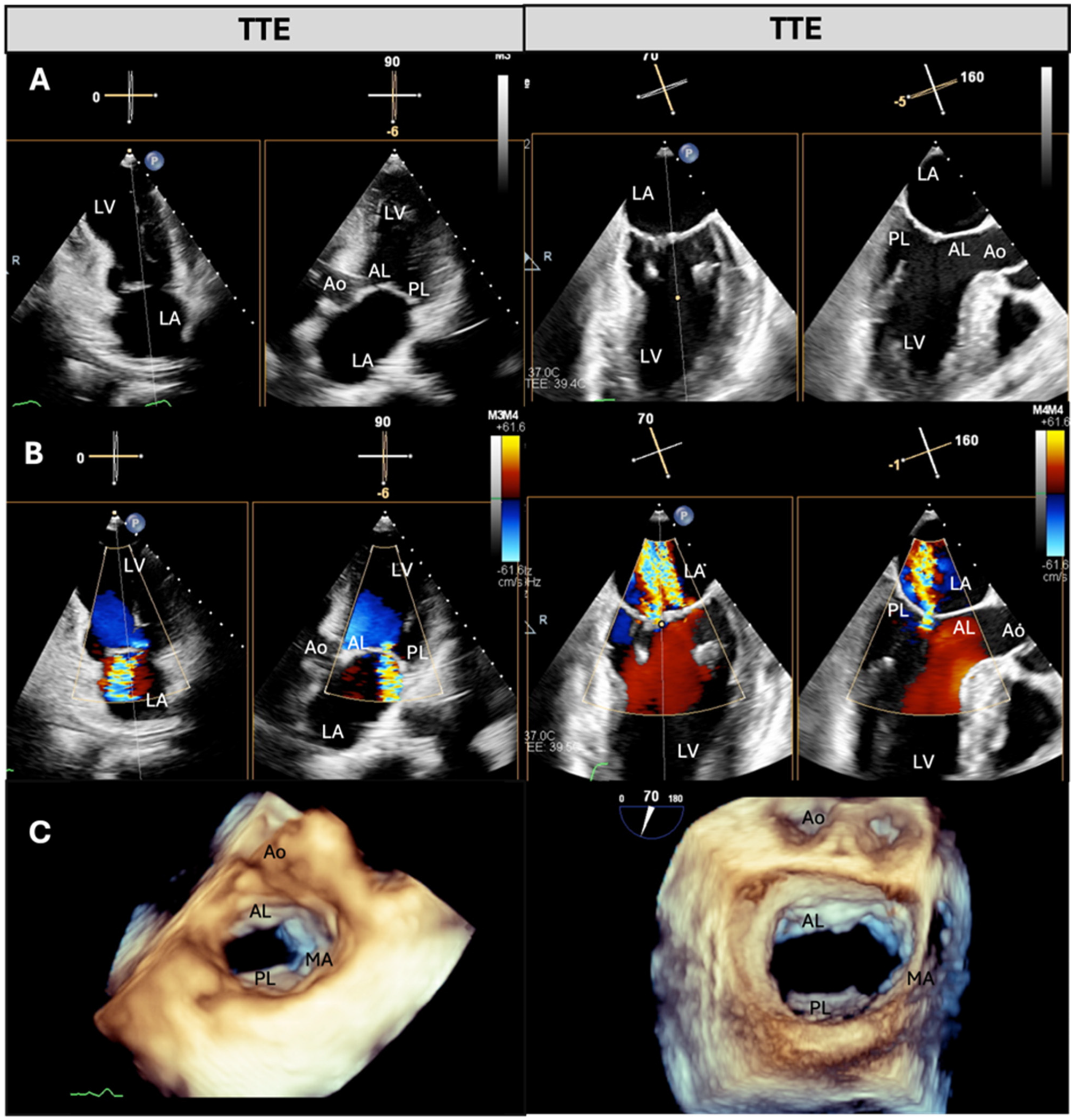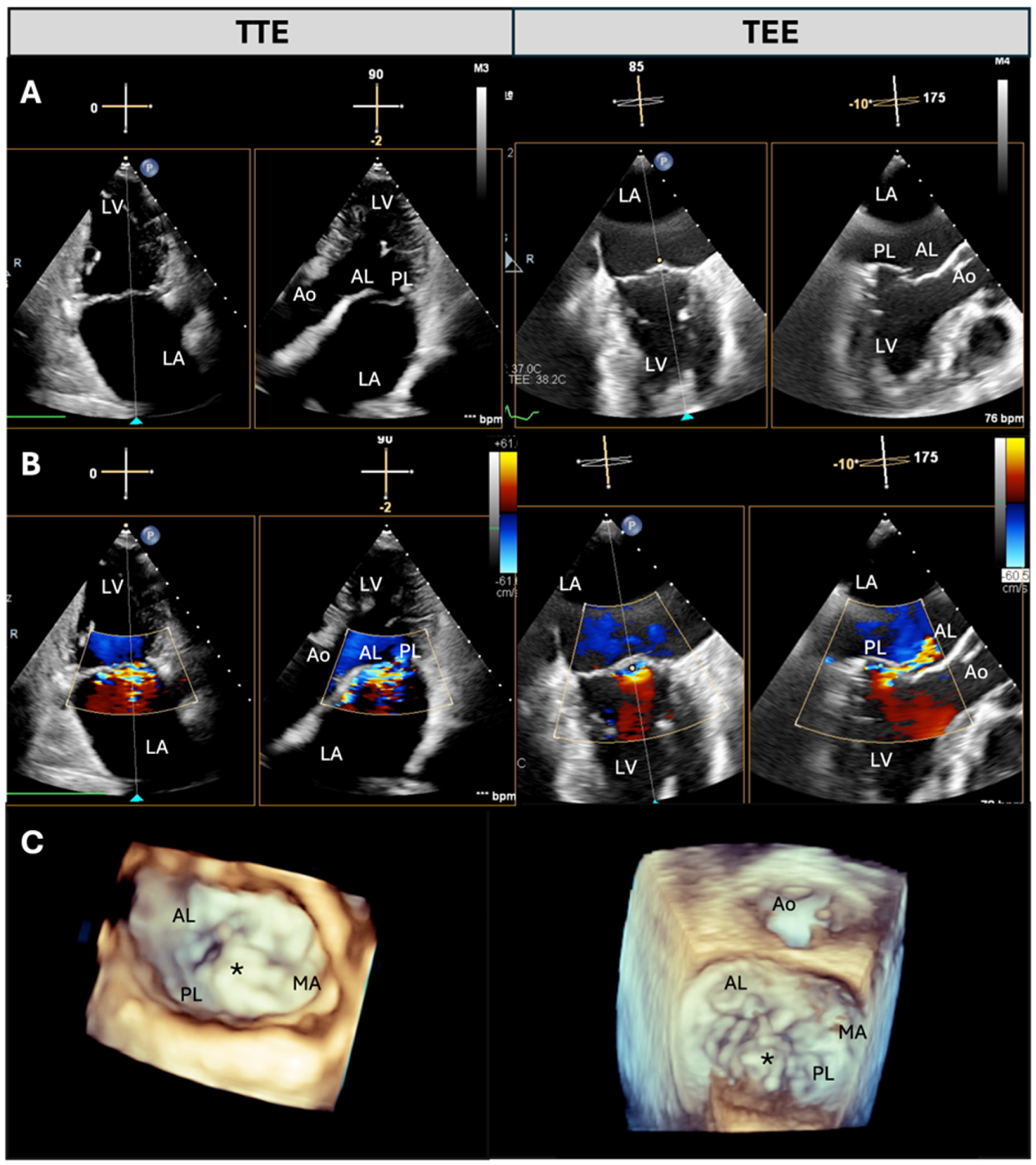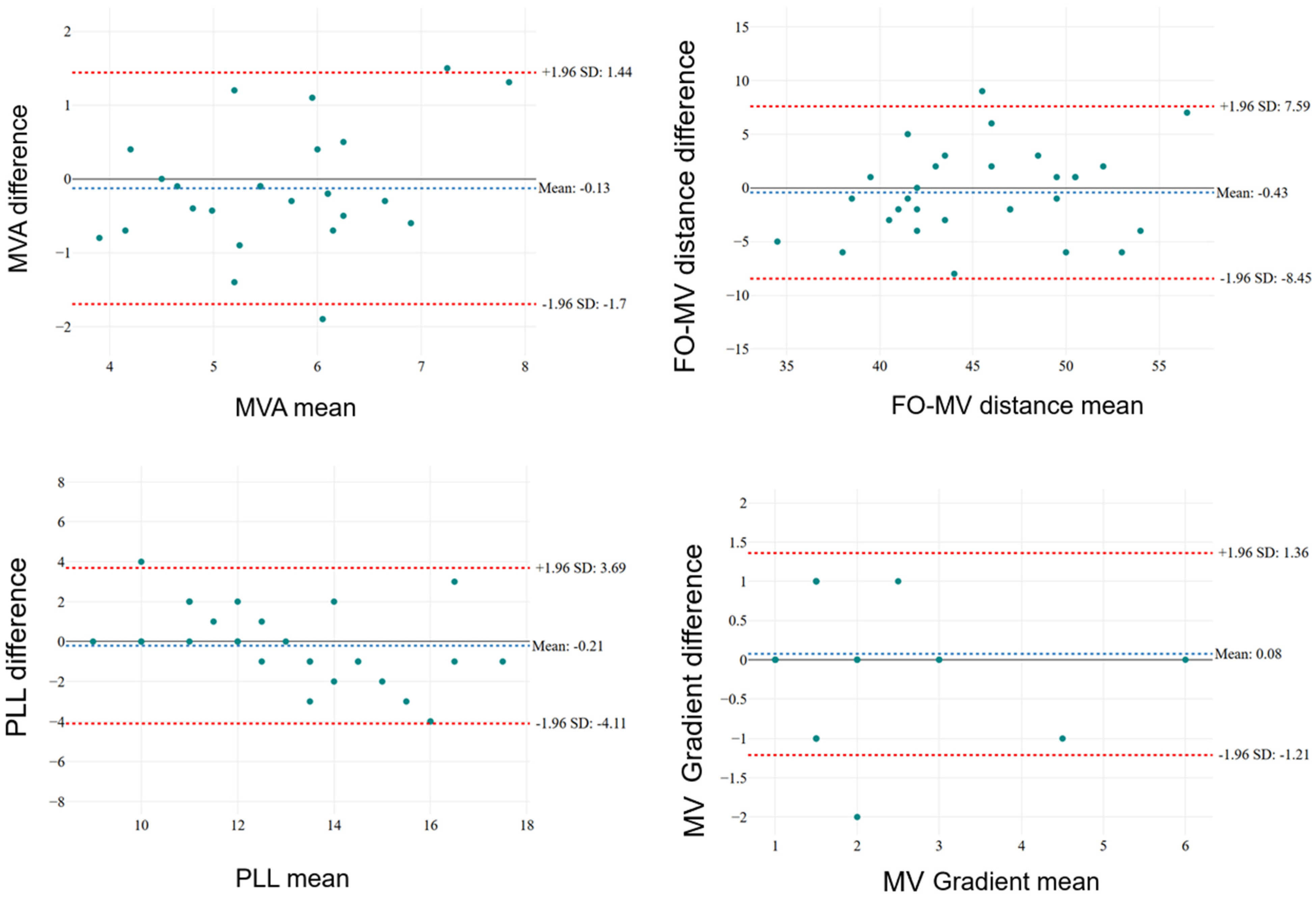Echocardiographic Screening for Transcatheter Edge-to-Edge Mitral Valve Repair: Correlation Between Transthoracic and Transesophageal Assessment
Abstract
1. Introduction
2. Materials and Methods
2.1. Study Population
2.2. TTE Protocol
2.3. TOE Protocol
2.4. Assessment of Anatomical Complexity for M-TEER Procedure
3. Statistical Analysis
4. Results
4.1. Comparison of TOE and TTE Parameters Useful for Evaluating M-TEER Feasibility
4.2. Correlation Between TOE and TTE Parameters in the Evaluation of M-TEER Feasibility
5. Discussion
Limitations
6. Conclusions
Author Contributions
Funding
Institutional Review Board Statement
Informed Consent Statement
Data Availability Statement
Acknowledgments
Conflicts of Interest
References
- Agricola, E.; Ancona, F.; Bartel, T.; Brochet, E.; Dweck, M.; Faletra, F.; Lancellotti, P.; Mahmoud-Elsayed, H.; Marsan, N.A.; Maurovich-Hovart, P.; et al. Multimodality imaging for patient selection, procedural guidance, and follow-up of transcatheter interventions for structural heart disease: A consensus document of the EACVI Task Force on Interventional Cardiovascular Imaging: Part 1: Access routes, transcatheter aortic valve implantation, and transcatheter mitral valve interventions. Eur. Heart J. Cardiovasc. Imaging 2023, 24, e209–e268. [Google Scholar] [CrossRef] [PubMed]
- Doherty, J.U.; Kort, S.; Mehran, R.; Schoenhagen, P.; Soman, P.; Dehmer, G.J.; Amin, Z.; Bashore, T.M.; Boyle, A.; Calnon, D.A.; et al. Rating Panel Members; Appropriate Use Criteria Task Force. ACC/AATS/AHA/ASE/ASNC/HRS/SCAI/SCCT/SCMR/STS 2017 Appropriate Use Criteria for Multimodality Imaging in Valvular Heart Disease: A Report of the American College of Cardiology Appropriate Use Criteria Task Force, American Association for Thoracic Surgery, American Heart Association, American Society of Echocardiography, American Society of Nuclear Cardiology, Heart Rhythm Society, Society for Cardiovascular Angiography and Interventions, Society of Cardiovascular Computed Tomography, Society for Cardiovascular Magnetic Resonance, and Society of Thoracic Surgeons. J. Nucl. Cardiol. 2017, 24, 2043–2063. [Google Scholar] [CrossRef] [PubMed]
- Vahanian, A.; Beyersdorf, F.; Praz, F.; Milojevic, M.; Baldus, S.; Bauersachs, J.; Capodanno, D.; Conradi, L.; De Bonis, M.; De Paulis, R.; et al. 2021 ESC/EACTS Guidelines for the management of valvular heart disease. Eur. Heart J. 2022, 43, 561–632, Erratum in: Eur. Heart J. 2022, 43, 2022. [Google Scholar] [CrossRef] [PubMed]
- Hahn, R.T.; Saric, M.; Faletra, F.F.; Garg, R.; Gillam, L.D.; Horton, K.; Khalique, O.K.; Little, S.H.; Mackensen, G.B.; Oh, J.; et al. Recommended Standards for the Performance of Transesophageal Echocardiographic Screening for Structural Heart Intervention: From the American Society of Echocardiography. J. Am. Soc. Echocardiogr. 2022, 35, 1–76, Erratum in: J. Am. Soc. Echocardiogr. 2022, 35, 447. [Google Scholar] [CrossRef] [PubMed]
- Mauri, L.; Garg, P.; Massaro, J.M.; Foster, E.; Glower, D.; Mehoudar, P.; Powell, F.; Komtebedde, J.; McDermott, E.; Feldman, T. The EVEREST II Trial: Design and rationale for a randomized study of the evalve mitraclip system compared with mitral valve surgery for mitral regurgitation. Am. Heart J. 2010, 160, 23–29. [Google Scholar] [CrossRef]
- Matteucci, A.; Bonanni, M.; Versaci, F.; Frati, G.; Peruzzi, M.; Sangiorgi, G.; Biondi-Zoccai, G.; Massaro, G. Cardiovascular medicine: A year in review. Minerva Cardiol. Angiol. 2022, 70, 40–55. [Google Scholar] [CrossRef] [PubMed]
- Hausleiter, J.; Lim, D.S.; Gillam, L.D.; Zahr, F.; Chadderdon, S.; Rassi, A.N.; Makkar, R.; Goldman, S.; Rudolph, V.; Hermiller, J.; et al. Transcatheter Edge-to-Edge Repair in Patients With Anatomically Complex Degenerative Mitral Regurgitation. J. Am. Coll. Cardiol. 2023, 81, 431–442. [Google Scholar] [CrossRef] [PubMed]
- McCarthy, P.M.; Whisenant, B.; Asgar, A.W.; Ailawadi, G.; Hermiller, J.; Williams, M.; Morse, A.; Rinaldi, M.; Grayburn, P.; Thomas, J.D.; et al. Percutaneous MitraClip Device or Surgical Mitral Valve Repair in Patients with Primary Mitral Regurgitation Who Are Candidates for Surgery: Design and Rationale of the REPAIR MR Trial. J. Am. Heart Assoc. 2023, 12, e027504. [Google Scholar] [CrossRef] [PubMed] [PubMed Central]
- Sorajja, P.; Sato, H.; Bapat, V.N.; Cavalcante, J.L.; Bae, R.; Fukui, M.; Stanberry, L.; Enriquez-Sarano, M. Contemporary Anatomic Criteria and Clinical Outcomes With Transcatheter Mitral Repair. Circ. Cardiovasc. Interv. 2023, 16, e012486. [Google Scholar] [CrossRef] [PubMed]
- Hausleiter, J.; Stocker, T.J.; Adamo, M.; Karam, N.; Swaans, M.J.; Praz, F. Mitral valve transcatheter edge-to-edge repair. EuroIntervention 2023, 18, 957–976. [Google Scholar] [CrossRef] [PubMed] [PubMed Central]
- Shuvy, M.; Maisano, F. Evolving indications for transcatheter mitral edge-to-edge repair. EuroIntervention 2024, 20, e230–e238. [Google Scholar] [CrossRef] [PubMed] [PubMed Central]
- Stolz, L.; Orban, M.; Braun, D.; Doldi, P.; Orban, M.; Stark, K.; Mehr, M.; Steffen, J.; Löw, K.; Hagl, C.; et al. Impact of asymmetric tethering on outcomes after edge-to-edge mitral valve repair for secondary mitral regurgitation. Clin. Res. Cardiol. 2022, 111, 869–880. [Google Scholar] [CrossRef] [PubMed]
- Oguz, D.; Padang, R.; Rashedi, N.; Pislaru, S.V.; Nkomo, V.T.; Mankad, S.V.; Malouf, J.F.; Guerrero, M.; Reeder, G.S.; Eleid, M.F.; et al. Risk for Increased Mean Diastolic Gradient after Transcatheter Edge-to-Edge Mitral Valve Repair: A Quantitative Three-Dimensional Transesophageal Echocardiographic Analysis. J. Am. Soc. Echocardiogr. 2021, 34, 595–603. [Google Scholar] [CrossRef] [PubMed]
- Zoghbi, W.A.; Adams, D.; Bonow, R.O.; Enriquez-Sarano, M.; Foster, E.; Grayburn, P.A.; Hahn, R.T.; Han, Y.; Hung, J.; Lang, R.M.; et al. Recommendations for Noninvasive Evaluation of Native Valvular Regurgitation: A Report from the American Society of Echocardiography Developed in Collaboration with the Society for Cardiovascular Magnetic Resonance. J. Am. Soc. Echocardiogr. 2017, 30, 303–371. [Google Scholar] [CrossRef] [PubMed]
- Bonanni, M.; Trimarchi, G.; Benedetti, G.; D’agostino, A.; Iuliano, G.; Manzo, R.; Capasso, R.; Cerone, E.; Paradossi, U.; Berti, S.; et al. Standardized 3D Transoesophageal Echocardiography Manoeuvre for Enhanced Tenting Height Evaluation During Transcatheter Mitral Valve Edge-to-Edge Repair. J. Clin. Med. 2024, 13, 6525. [Google Scholar] [CrossRef] [PubMed]
- Grayburn, P.A.; She, L.; Roberts, B.J.; Golba, K.S.; Mokrzycki, K.; Drozdz, J.; Cherniavsky, A.; Przybylski, R.; Wrobel, K.; Asch, F.M.; et al. Comparison of Transesophageal and Transthoracic Echocardiographic Measurements of Mechanism and Severity of Mitral Regurgitation in Ischemic Cardiomyopathy (from the Surgical Treatment of Ischemic Heart Failure Trial). Am. J. Cardiol. 2015, 116, 913–918. [Google Scholar] [CrossRef] [PubMed] [PubMed Central][Green Version]
- Papadopoulos, K.; Ikonomidis, I.; Özden, Ö.; Tzikas, A.; Arampatzis, C.A.; Vannan, M.A. Level of agreement between three-dimensional transthoracic and transesophageal echocardiography for mitral annulus evaluation: A feasibility and comparison study. Echocardiography 2022, 39, 1512–1521. [Google Scholar] [CrossRef] [PubMed]
- Berthelot-Richer, M.; Vakulenko, H.V.; Calleja, A.; Woo, A.; Thavendiranathan, P.; Poulin, F. Two-dimensional transthoracic measure of mitral annulus in mitral valve prolapse and moderate to severe regurgitation: A method comparison analysis with three-dimensional transesophageal echocardiography. J. Cardiovasc. Imaging 2024, 32, 2. [Google Scholar] [CrossRef] [PubMed] [PubMed Central]
- Gripari, P.; Mapelli, M.; Bellacosa, I.; Piazzese, C.; Milo, M.; Fusini, L.; Muratori, M.; Ali, S.G.; Tamborini, G.; Pepi, M. Transthoracic echocardiography in patients undergoing mitral valve repair: Comparison of new transthoracic 3D techniques to 2D transoesophageal echocardiography in the localization of mitral valve prolapse. Int. J. Cardiovasc. Imaging 2018, 34, 1099–1107. [Google Scholar] [CrossRef] [PubMed]
- Fioretti, G.; Tolomei, A.; Ciaramella, P.; Lio, A.; Cristiano, E.; Cacioli, G.; Tempestini, F.; Ranocchi, F.; Maestrini, V.; Pergolini, A. Study of Degenerative Mitral Regurgitation Using Three-Dimensional Echocardiography and EchoPAC GE Health Care Software 4D Auto MVQ: Comparison Between Transthoracic and Transesophageal Examination. Echocardiography 2024, 41, e70040. [Google Scholar] [CrossRef] [PubMed]



| Variables | Total (N = 40) |
|---|---|
| Age, yrs | 79 ± 6.7 |
| Female, N (%) | 15 (37.5) |
| Atrial fibrillation, N (%) | 25 (62.5) |
| Previous HF hospitalization, N (%) | 12 (30) |
| CRT-D, N (%) | 2 (5) |
| ICD, N (%) | 2 (5) |
| Previous MI, N (%) | 16 (40) |
| B-blockers, N (%) | 26 (65) |
| ACE-I/ARB/ARNI, N (%) | 30 (75) |
| MRA, N (%) | 20 (50) |
| Furosemide > 50 mg, N (%) | 15 (37.5) |
| SGLT2i, N (%) | 15 (23.4) |
| NYHA ≥ III, N (%) | 29 (72.5) |
| egenerative MR, N (%) | 18 (45) |
| Functional MR, N (%) | |
| 12 (30) 10 (25) |
| Imaging quality | |
| 8 (20) 23 (57.5) 9 (22.5) |
| EROA, cmq | 0.36 ± 0.2 |
| RV, mL | 55.9 ± 7.8 |
| LVEF, % | 57 (46.25–66.74) |
| LVEDD, mm | 52 (48–58) |
| LVESD, mm | 33 (27.5–40) |
| LVEDV, mL | 100.5 (80–126) |
| LVESV, mL | 42.5 (25.25–66) |
| LA area, cmq | 26 (21–31.5) |
| LA volume, mL | 86 (68–129) |
| PAPs, mmHg | 43 (33–60) |
| TR (≥moderate), N (%) | 5 (12.5) |
| Variables | TTE Mean ± SD | TOE Mean ± SD | 95% CI | Paired t-Test | Bland–Altman |
|---|---|---|---|---|---|
| MVA, cm2 | 5.5 ± 1.1 | 5.8 ± 1.2 | −0.466–0.208 | 0.438 | 0.323 |
| Transvalvular gradient, mmHg | 1.9 ± 1.1 | 1.8 ± 1.3 | −1.970–1.3559 | 0.714 | 0.109 |
| Posterior leaflet length, mm | 13 ± 2 | 13.5 ± 3.3 | −1.032–0.047 | 0.641 | 0.000 |
| Distance septal puncture point-mitral valve | 44 ± 6.1 | 44.9 ± 5 | −1.970–1.355 | 0.706 | 0.635 |
| Variables | TTE N (%) | TOE N (%) | Observed Agreement (%) | Kappa Value | p-Value |
|---|---|---|---|---|---|
| Evidence of Barlow’s disease | 2 (5) | 3 (7.5) | 97.5 | 0.787 | <0.001 |
| Evidence of flail | 7 (17.5) | 11 (27.5) | 90 | 0.717 | <0.001 |
| Bi-leaflet prolapse | 2 (5) | 3 (7.5) | 95 | 0.640 | <0.001 |
| Evidence of annular and/or leaflet calcification | 10 (25) | 10 (25) | 97.5 | 0.930 | <0.001 |
| >2 independent jets | 9 (22.5) | 13 (32.5) | 90 | 0.752 | <0.001 |
| Evidence of cleft | 0 (0) | 3 (7.5) | 32.5 | ||
| Technical feasibility of MR * | |||||
| 22 (68.8) 7 (21.9) 3 (9.4) | 21(65.6) 9 (28.1) 2 (6.3) | 87.5 | 0.546 | <0.000 |
Disclaimer/Publisher’s Note: The statements, opinions and data contained in all publications are solely those of the individual author(s) and contributor(s) and not of MDPI and/or the editor(s). MDPI and/or the editor(s) disclaim responsibility for any injury to people or property resulting from any ideas, methods, instructions or products referred to in the content. |
© 2025 by the authors. Licensee MDPI, Basel, Switzerland. This article is an open access article distributed under the terms and conditions of the Creative Commons Attribution (CC BY) license (https://creativecommons.org/licenses/by/4.0/).
Share and Cite
Bonanni, M.; Pizzino, F.; Benedetti, G.; Capasso, R.; Manzo, R.; Iuliano, G.; Trimarchi, G.; D’Agostino, A.; Paradossi, U.; Gimelli, A.; et al. Echocardiographic Screening for Transcatheter Edge-to-Edge Mitral Valve Repair: Correlation Between Transthoracic and Transesophageal Assessment. J. Cardiovasc. Dev. Dis. 2025, 12, 149. https://doi.org/10.3390/jcdd12040149
Bonanni M, Pizzino F, Benedetti G, Capasso R, Manzo R, Iuliano G, Trimarchi G, D’Agostino A, Paradossi U, Gimelli A, et al. Echocardiographic Screening for Transcatheter Edge-to-Edge Mitral Valve Repair: Correlation Between Transthoracic and Transesophageal Assessment. Journal of Cardiovascular Development and Disease. 2025; 12(4):149. https://doi.org/10.3390/jcdd12040149
Chicago/Turabian StyleBonanni, Michela, Fausto Pizzino, Giovanni Benedetti, Rosangela Capasso, Rachele Manzo, Giuseppe Iuliano, Giancarlo Trimarchi, Andreina D’Agostino, Umberto Paradossi, Alessia Gimelli, and et al. 2025. "Echocardiographic Screening for Transcatheter Edge-to-Edge Mitral Valve Repair: Correlation Between Transthoracic and Transesophageal Assessment" Journal of Cardiovascular Development and Disease 12, no. 4: 149. https://doi.org/10.3390/jcdd12040149
APA StyleBonanni, M., Pizzino, F., Benedetti, G., Capasso, R., Manzo, R., Iuliano, G., Trimarchi, G., D’Agostino, A., Paradossi, U., Gimelli, A., Berti, S., & Mariani, M. (2025). Echocardiographic Screening for Transcatheter Edge-to-Edge Mitral Valve Repair: Correlation Between Transthoracic and Transesophageal Assessment. Journal of Cardiovascular Development and Disease, 12(4), 149. https://doi.org/10.3390/jcdd12040149









